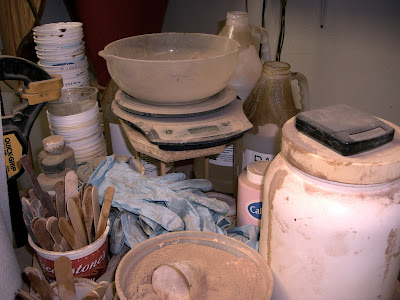How does a harp, like this little 22-string Triplett harp I'm holding, come to be?

Well, I found out. Not from books but from a bonafide master harp builder, Rick Kemper from Sligo Harps. Rick had me start by learning first how to make the hollow, round back shell of the harps. Below, you'll see a vacuum press that Rick constructed for molding the shape of the shell. He instructed me in making the "sandwich". Making a harp shell sandwich consists of
- choosing, bookmatching, cutting, and sanding wood veneers to fit on the outside of the shell
- laying down the plywood caul onto the nails of the "sandwich" board (like the long boards Subway uses to assemble their party subs)
- laying out a piece of butcher paper on the caul
- mixing 8 scoops of powder plastic resin to 4 scoops of water and mixing like crazy to get the powder mixed in well (There were a couple times I didn't mix it right and ended up with clumpy epoxy--not good for a fine craft as this)
- spreading epoxy on a trapezoidal cut piece of plywood with a roller (With practice, Rick showed me how to become a talented harp builder who knows just the right amount of bead to spread to the edge without making a mess of the workbench, putting it on the butcher paper, and with epoxy spread on the outside of the second piece of plywood, sandwiching them together
- lying the veneer on the outer epoxy covered plywood
- wrapping the sandwich in the butcher paper and taping it down
- transferring the sandwich onto the blue foam form
- sliding the form into the vacuum bag, precisely in the middle so there is equal pressure as the bag pulls the wood into the form
- turn on the vacuum press
Rick found me willing and able to make the shells, so he set me to work during the day while he worked his day job in D.C.
After I finished the shells, I'd put them into a cool wedge holding board Rick made to keep them safe until we could put the sound holes and support struts inside.





3 comments:
Way to go Jaz! Looks like a great time!
I always wondered how to do that.....
Keep up the good work Ms. Apprentice.
You're a really neat person!
Post a Comment